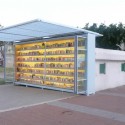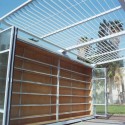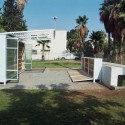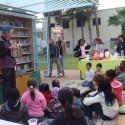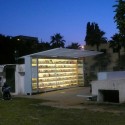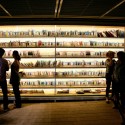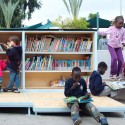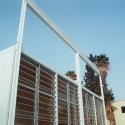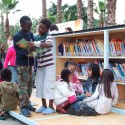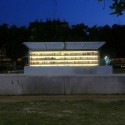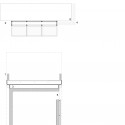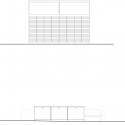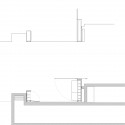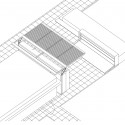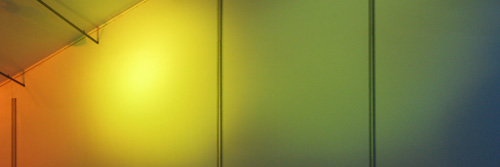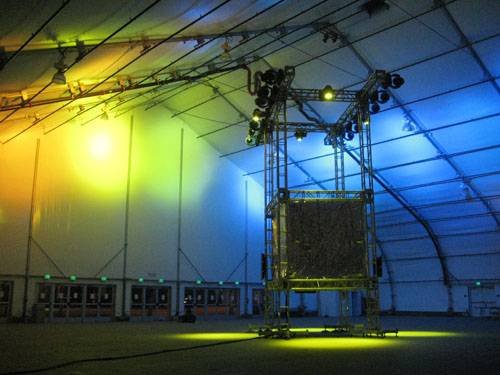Friday, September 02. 2011
Does Facial Recognition Technology Mean the End of Privacy?
Via Computed·Blg via big think
by Dominic Basulto
-----
At the Black Hat security conference in Las Vegas, researchers from Carnegie Mellon demonstrated how the same facial recognition technology used to tag Facebook photos could be used to identify random people on the street. This facial recognition technology, when combined with geo-location, could fundamentally change our notions of personal privacy. In Europe, facial recognition technology has already stirred up its share of controversy, with German regulators threatening to sue Facebook up to half-a-million dollars for violating European privacy rules. But it's not only Facebook - both Google (with PittPatt) and Apple (with Polar Rose) are also putting the finishing touches on new facial recognition technologies that could make it easier than ever before to connect our online and offline identities. If the eyes are the window to the soul, then your face is the window to your personal identity.
And it's for that reason that privacy advocates in both Europe and the USA are up in arms about the new facial recognition technology. What seems harmless at first - the ability to identify your friends in photos - could be something much more dangerous in the hands of anyone else other than your friends for one simple reason: your face is the key to linking your online and offline identities. It's one thing for law enforcement officials to have access to this technology, but what if your neighbor suddenly has the ability to snoop on you?
The researchers at Carnegie Mellon showed how a combination of simple technologies - a smart phone, a webcam and a Facebook account - were enough to identify people after only a three-second visual search. Hackers - once they can put together a face and the basics of a personal profile - like a birthday and hometown - they can start piecing together details like your Social Security Number and bank account information.
And the Carnegie Mellon technology used to show this? You guessed it - it's based on PittPatt (for Pittsburgh Pattern Recognition Technology), which was acquired by Google, meaning that you may soon be hearing the Pitter Patter of small facial recogntion bots following you around any of Google's Web properties. The photo in your Google+ Profile, connected seamlessly to video clips of you from YouTube, effortlessly linked to photos of your family and friends in a Picasa album - all of these could be used to identify you and uncover your private identity. Thankfully, Google is not evil.
Forget being fingerprinted, it could be far worse to be Faceprinted. It's like the scene from The Terminator, where Arnold Schwarzenegger is able to identify his targets by employing a futuristic form of facial recognition technology. Well, the future is here.
Imagine a complete stranger taking a photo of you and immediately connecting that photo to every element of your personal identity and using that to stalk you (or your wife or your daughter). It happened to reality TV star Adam Savage - when he uploaded a photo to his Twitter page of his SUV parked outside his home, he didn't realize that it included geo-tagging meta-data. Within hours, people knew the exact location of his home. Or, imagine walking into a store, and the sales floor staff doing a quick visual search using a smart phone camera, finding out what your likes and interests are via Facebook or Google, and then tailoring their sales pitch accordingly. It's targeted advertising, taken to the extreme.
Which is not to say that everything about facial recognition technology is scary and creepy. Gizmodo ran a great piece explaining all the "advantages" of being recognize onlined. (Yet, two days later, Gizmodo also ran a piece explaining how military spies could track you down almost instantly with facial recognition technology, no matter where you are in the world).
Which raises the important question: Is Privacy a Right or a Privilege? Now that we're all celebrities in the Internet age, it doesn't take much to extrapolate that soon we'll all have the equivalent of Internet paparazzi incessantly snapping photos of us and intruding into our daily lives. Cookies, spiders, bots and spyware will seem positively Old School by then. The people with money and privilege and clout will be the people who will be able to erect barriers around their personal lives, living behind the digital equivalent of a gated community. The rest of us? We'll live our lives in public.
Personal comment:
Again, this reminds me of this previous "| rblg" post concerning "publicy". And as I mentioned at that time, it could also be useful in the context of a new work we are working on, Paranoid Shelter. There are .
Tuesday, July 19. 2011
La mort d'internet se confirme un peu plus à Bruxelles
Via Numerama
-----
Par Guillaume Champeau - publié le Lundi 18 Juillet 2011 à 10h39 - posté dans Télécoms
Les grands patrons des télécoms réunis par Bruxelles pour plancher sur les modes de financement du très haut débit à court terme dans l'Union Européenne ont accouché, sans surprise, d'une série de propositions qui enterrent la neutralité du net au profit d'un accès à plusieurs internets, plus ou moins riches selon l'abonnement payé. Des propositions qui enfoncent la porte déjà ouverte par la Commission Européenne.
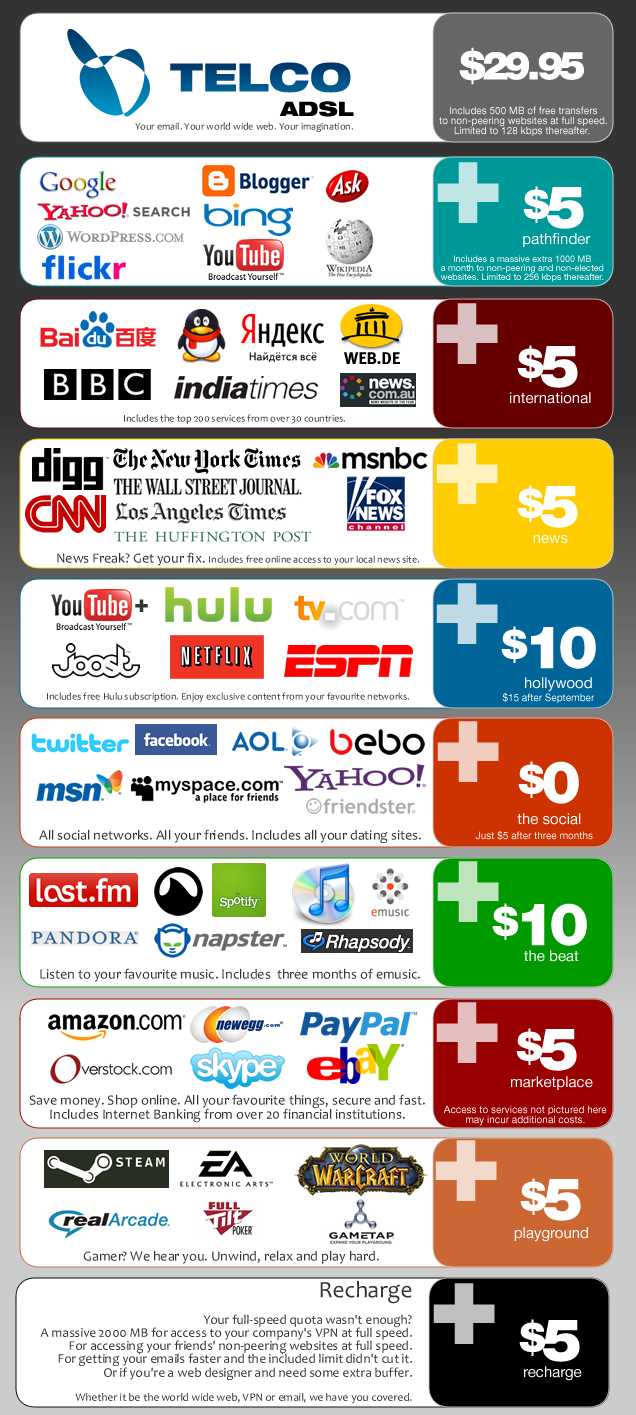

Souvenez-vous. C'était en mars dernier. Sans grand bruit, la Commission Européenne réunissait à Bruxelles près d'une quarantaine de grands patrons des télécoms : Steve Jobs (Apple), Xavier Niel (Free), Stéphane Richard (Orange), Jean-Phillipe Courtois (Microsoft), Jean-Bernard Lévy (Vivendi), Stephen Elop (Nokia),..
La réunion avait pour but de demander aux industriels comment, selon eux, "assurer au mieux les investissements de très haut niveau du secteur privé nécessaires pour le déploiement des réseaux haut-débit de prochaine génération pour maintenir la croissance d'internet". La Commission souhaite en effet rendre possible l'objectif fixé par l'Agenda Numérique de l'Europe, qui prévoit que tous les Européens aient accès à Internet à 30 Mbps minimum d'ici 2020, et au moins la moitié d'entre eux à 100 Mbps.
Pour élaborer les propositions, un groupe de pilotage composé avait été désigné, composé par Jean-Bernard Lévy de Vivendi, Ben Verwaayen d'Alcatel-Lucent, et René Obermann de Deutsche Telekom. "Preuve qu'il y a dès la composition du groupe la volonté de trouver un équilibre entre le financement des réseaux et le financement des contenus, ce qui n'est jamais très bon signe pour la neutralité du net", pressentions-nous alors.
Le résultat est encore pire que nos craintes de l'époque, et confirme la tendance exprimée par la Commission Européenne le mois dernier, lorsqu'elle a dit vouloir privilégier le libre marché à la défense de la neutralité du net.
11 propositions pour enterrer la neutralité des réseaux
Lors d'une seconde réunion le 13 juillet dernier, les trois compères ont en effet remis une série de 11 propositions, insoutenables pour les partisans de la neutralité du net. Prenant l'objectif européen comme une aubaine pour prétendre que le déploiement du très haut-débit à court terme ne peut se faire sur les mêmes bases que précédemment, le groupe conclut que l'Europe "doit encourager la différenciation en matière de gestion du trafic pour promouvoir l’innovation et les nouveaux services, et répondre à la demande de niveaux de qualité différents". Il s'agit donc de faire payer plus cher ceux qui souhaitent accéder sans bridage à certains services qui demandent davantage de bande passante, ou "une moindre latence, ce qui est capital dans le jeu vidéo", explique le patron de Vivendi à la Tribune.
Il est aussi clairement envisagé de permettre aux éditeurs de services d'acheter un accès privilégié aux abonnés à Internet, pour que leur service soit plus rapide que celui des concurrents qui ne paieraient pas la dîme. "La valorisation du potentiel des marchés bifaces apportera plus d’innovation, d’efficacité et un déploiement plus rapide des réseaux de nouvelle génération, au bénéfice des consommateurs et des industries créatives", croit pouvoir affirmer le groupe de travail.
Par ailleurs, il justifie l'absence de représentants d'organisations de citoyens et de consommateurs parmi la quarantaine de dirigeants consultés par Bruxelles. "Les intérêts à long terme des consommateurs coïncident avec la promotion de l’innovation et l’investissement". Ils n'ont qu'à subir la mort de la neutralité du net, c'est au final dans leur intérêt, assurent les patrons des télécoms.
Dans La Tribune, Jean-Bernard Lévy raconte que la réunion du 13 juillet s'est "formidablement mieux passée que l'on ne pensait", et qu'elle a parmi de découvrir "un degré de consensus remarquable et inattendu entre ces acteurs de toute la chaîne de valeur, opérateurs, fabricants, agrégateurs, éditeurs de chaînes, etc". En oubliant, au passage, que les internautes sont les premiers acteurs de cette chaîne de valeur. Non seulement parce qu'ils payent leur accès à Internet. Mais aussi parce qu'ils sont aujourd'hui, et de très loin, les premiers producteurs des contenus qui y circulent.
Personal comment:
This can't be good... (Thanks Nicolas for the link)
Wednesday, April 20. 2011
White styles
Via @joelvacheron
-----
Documentary made after William Foote Whyte's seminal book "Street Corner Society".
Related Links:
Friday, March 04. 2011
McCall's mile high Column of cloud
Via Creative Review
-----
by Patrick Burgoyne
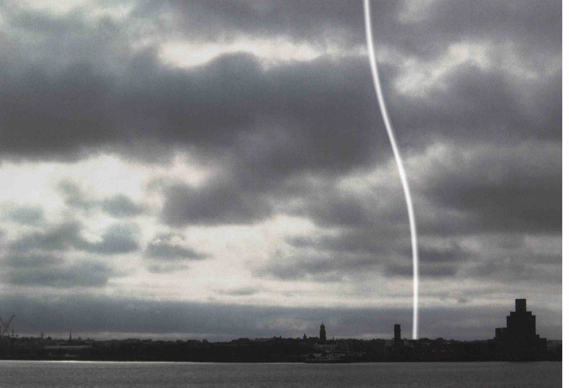
Artist Anthony McCall has unveiled plans to create a spinning column of cloud a mile high on Merseyside next year as part of the Cultural Olympiad for 2012
McCall's Column will be sited at Wirral Waters in Merseyside and be visible across the North West region throughout the Olympic year. It was commissioned by Arts Council England as part of Artists taking the lead, a series of 12 public art commissions across the UK to celebrate the London 2012 Cultural Olympiad.
Apparently, a “coherent convection” of cloud and mist, will be created by gently rotating the water on the surface of the Mersey and then adding heat which will make it lift into the air like a water spout or dust devil (see here).
A scale model of the installation is on show at McCall's current London show.
Related Links:
Personal comment:
Anthony McCall strikes back! I really wonder if this will work (and if it will look like the picture...), but it's a quite beautiful project nonetheless.
Thursday, February 24. 2011
Wireless Stories: optimism and doubts about the future of public space
Via The Mobile City
-----
by Martijn de Waal
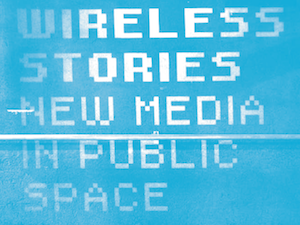
Last week the Dutch Mediafund and the Design department of the Sandberg Academy organized the conference Wireless Stories: new media in public space. The Mobile City was invited to provide the opening keynote (by Michiel de Lange) as well as a closing statement (yours truly), so here are my observations of the day:
What struck me most after a day’s worth of presentations of new media interventions – varying from a moodwall to complex multinlineair location based storytelling projects - was that the talks articulated both a sense of optimism as well as a sense of doubt.
There was a lot of optimism that new media would make urban public spaces more interesting, layering them with depth, connecting people, spark democratic debates, turn them into playgrounds and empower citizens.
Yet at the same time there were some doubts. Although the opportunities are there, many of the speakers were still not sure how exactly they are to be effectuated. How do we indeed engage people in public spaces with the help of these new technologies?
Optimism: enhancing public space with locative and wireless media
Let’s start with the optimist visions. During the day several visions of what public space is, which functions it fulfills, and what is problematic about it were addressed.
1. Public Space as a place for deliberate democracy
This is of course a vision that builds upon theories by the likes of Hannah Arendt and Jurgen Habermas, who have theorized public space as a meeting ground for citizens where they come together to discuss their common future.
At the conference Tobias Ebsen presented Climate on the Wall, an interactive mediafacade by the Digital Urban Living Lab (we have written about this project before) at Aarhus University. Climate on the Wall is based on the concept of ‘magnetic poetry’: text balloons with words are projected on a facade, and passers-by can drag the words in any order, forming poetic sentences, political statements or just nonsense.
The hope expressed in the project was that people would use the installation to make statements about the environment. However, that didnot always happen. People just started playing with it, or even using the installation in a subversive way. What the creators didnot forsee though is that debate did take place: not on the wall itself, but rather amongst the bystanders/ audience. The playful and sometimes subversive uses had turned their installation into a conversation piece.
2. Public Space as a theatre, as a stage for the representation of cultural identities and political movements
Various speakers at the conference alluded to the current events in Tunesia and Egypt, reflecting on the role of public space as a place for the representation of political movements. These physical and bodily mass events are now partially coordinated by the use of digital media in the form of social networks ans sms messages. Although in my opinion claims of a ‘Twitter revolution’, where the technology causes the revolts should be distrusted, there is no doubt an interesting dynamic going on between these media and the way collective political imaginations are shaped as well as the (organization of) physical movements through which these imaginations are articulated.
On a different but somewhat comparable plane, public space can also be understood as a site for cultural representation, where (sub)cultures proudly display themselves, (temporarily) claim a part of public space to assert their right to exist, or just to make it their own. At the conference the dance film Diamond Dancers bu Quirine Racke and Helena Muskens made me think of this particular approach of public space. The film is a flash mob performance of provincial line dancers who travel to amsterdam to stage a surprise performance on one of the main public squares.
3 Public space as a site for cultural experiences and exchanges
A number of speakers approached public space as a stage for cultural experiences. In these examples, wireless media are to enhance the experience of a particular place, for instance by showing historic layers, or connect places to personal stories, to make people aware of alternative points of view or just to tell an exciting story or engage people in a game.
Dick van Dijk of Waag Society showed their 7scenes platform – a tool for the annotation of maps and the authoring of location based stories and games. They are using this tool to develop an app for the Amsterdam museum – as part of an international trend sometimes called ‘museums without walls’. Earlier they also authored other locative experiences. For instance Madretsma.net is a route through Amsterdam commemorating the slavery trade. Here, the interface was much more low tech: at particular points in the city users could call a phone number and listen to a particular story connected to that place.
Michael Epstein of Untravel Media also showed a number of what he had called ‘terratives’ – narrative that are told on location. (see an earlier Mobile City report for a more in depth analysis of the genre). For instance, in Boston they created a project named Walking Cinema: Murder on Beacon Hill. This project took the form of a walk along a number of locations in Boston, where scenes (movie clips) from a 19th century murder mystery were played out on a smart phone.
These are not just geo-annotated movie clips. To draw the user in, some dramaturgic elements were added. First there was a narrator, that invited participants to follow in her footsteps, also turning the player into a character. Second, actual physical props played an important role and third, players / viewers also had to interact with real people in the actual surroundings. For instance one of the scenes took place in the lobby of a luxurious hotel and some employees there were involved in the story.
Martin Rieser showed The third woman a project that was even more complex in its story telling. Where Walking Cinema was a more or less lineair narrative that played out on location, the Third Woman added interactive elements, where participants could influence the mood of particular filmclips they were shown.
4 Feeling at home in Public Space
A fourth approach of wireless media I encountered was not so much connected to a particular understanding of public space, but rather trying to deal with one of its inherent problems. If public space is a place where we encounter strangers, who might also be different from ourselves, than for many this can also lead to a somewhat uncanny feeling. Especially at certain locations that are not lively public spaces but somewhat neglected passage ways, people can easily feel unsafe.
Can designers intervene with digital or wireless media to make citizens feel more at home in public space? For instance by using visualizations of harvested mobile phone or social network data that show collective rhythms of citizens?
In this category, Matthijs ten Berge showed his Moodwall – a beautiful light installation in a dark tunnel in de Bijlmer area of Amsterdam. Its interactive light patterns are to make passers-by feel more at home in these surroundings.
The doubts
I was (although not necessarily unpleasantly) surprised by all these optimist visions , since often in the general debate about the affordances of digital media in relation to public space dystopian scenario’s are evoked. Digital and locative media are after all not only media of connection, providing added layers of experience. They also have the affordance to turn the city into a panopticon and allow their users to retract in their safe, personal communication bubbles – turning public spaces into private experiences. These more critical points of view were sometimes mentioned, but not really addressed during the conference.
That is not to say that there were no doubts expressed. On the contrary, although speakers were overall enthusiastic about the opportunities of digital media, they also found that the actual implementation, scalability and engagement of users is hard to accomplish.
The technology is here: we can now tweet, geotag, program urban screens or use the private screens of the mobile phone. Yet the question remains: how to actually engineer an interesting experience, how to seduce people to actually interact with the content? This question is all the more relevant, since one of the characteristics of wireless media is that they often are invisible. So it is not only a matter of engaging people but also make them aware of the added layers etc. All of the projects shown at the conference had somehow struggled with these issues, and it is fair to say that this will also remain one of the most important questions in wireless storytelling in the near future.
Lessons Learned
With regard to the design of locative experiences, I took two important lessons from these examples. The first is – as Michael Epstein put it strikingly – ‘Matter is a test for our curiosity’, meaning that material artefacts in real space can draw people into the story. The tension in locative storytelling projects comes from actually drawing in objects, locations and people, making it tactical and physical. Especially the use of people can really make the experience much more appealing. Although this is also very hard to arrange, but it is worth to try to draw in local shopkeepers, hotel lobby attendants or others into the scenario. In effect, as a narrative discipline locative storytelling is probably closest to theatre – you need a strong dramaturgy, script, actors and perhaps a gameplay. This also can make it hard to scale locative productions or reenact them at other locations. (see our earlier article Some notes on the design of pervasive games for more thoughts about this)
A second lesson, with regard to locative projects that try to engage people into discussions or exchange is to not overdetermine the design. Make it a playful design to draw people in, but also leave some room for people to appropriate it, to play with the rules of the game. Sometimes its more useful to design a conversation piece than wanting to direct the conversation itself.
Revolutionary space
Via Mammoth
-----
by mammoth
In saying anything about the past couple weeks’ events in Egypt, we have to begin by saying that we know little about Egypt. (What we do know — that it is absolutely appropriate to celebrate the downfall of a tyrant, however limited our understanding of Egypt may be and however complicit America has been in sustaining that tyrant — is well said here by Will Wilkinson.)
With that caveat in place, there is one specific aspect of these events (or, really, the analysis of these events) that we find curious. It has been hard to escape the flood of commentary (for example) that attributes the catalysis and successful organization of the revolution to Twitter and Facebook. But despite the key role that Tahrir Square played and how closely it became associated with the revolution itself, there has been little analysis of the role of public space — which we find just as interesting as the role of social media — in a successful revolution [1]. (One notable exception to this that we are aware of is the New York Times‘ day-by-day mapping of the protests here and here.)
Questions come easily to mind. How would the revolution have been different if the public spaces of Cairo were different? What if the protestors had been forced to carry out their protests on narrow streets, where the sheer magnitude of the crowd could never be captured in a single gaze, as it could in Tahrir? Both the pitched din of outrage carried across social media and the pitched battles between protestors and pro-Mubarak forces occurred in kinds of space (albeit very different kinds of space), but can a revolution sustain itself in space without becoming physically instantiated? How does this relationship change when physical space can be hacked from virtual space? What conclusions about the role of public space in peaceful revolution could be drawn from a comparative study of how revolutionaries used the public spaces of Tunis, Cairo, and Alexandria?
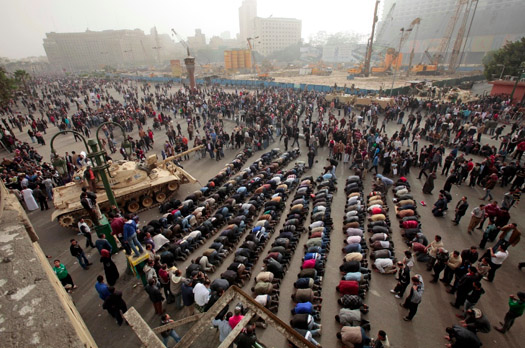
[via The Big Picture]
This story in the Wall Street Journal (not behind a paywall at the time of this post, but that may change) paints a fascinating picture of the ways in which the planners of the Egyptian protests considered specific spatial characteristics of their city in tandem with the logistics of communication, the willingness of potential participants to join, and the expected resistance from establishment organizations:
They chose 20 protest sites, usually connected to mosques, in densely populated working-class neighborhoods around Cairo. They hoped that such a large number of scattered rallies would strain security forces, draw larger numbers and increase the likelihood that some protesters would be able to break out and link up in Tahrir Square.
The group publicly called for protests at those sites for Jan. 25, a national holiday celebrating the country’s widely reviled police force. They announced the sites of the demonstrations on the Internet and called for protests to begin at each one after prayers at about 2 p.m.
But that wasn’t all.
“The 21st site, no one knew about,” Mr. Kamel said.
[...]
They sent small teams to do reconnaissance on the secret 21st site. It was the Bulaq al-Dakrour neighborhood’s Hayiss Sweet Shop, whose storefront and tiled sidewalk plaza—meant to accommodate outdoor tables in warmer months—would make an easy-to-find rallying point in an otherwise tangled neighborhood no different from countless others around the city.The plotters say they knew that the demonstrations’ success would depend on the participation of ordinary Egyptians in working-class districts like this one, where the Internet and Facebook aren’t as widely used. They distributed fliers around the city in the days leading up to the demonstration, concentrating efforts on Bulaq al-Dakrour.
[...]
In the days leading up to the demonstration, organizers sent small teams of plotters to walk the protest routes at various speeds, to synchronize how separate protests would link up.On Jan. 25, security forces predictably deployed by the thousands at each of the announced demonstration sites. Meanwhile, four field commanders chosen from the organizers’ committee began dispatching activists in cells of 10. To boost secrecy, only one person per cell knew their destination.
[...]
The other marches organized at mosques around the city failed to reach Tahrir Square, their efforts foiled by riot-police cordons. The Bulaq al-Dakrour marchers, the only group to reach their objective, occupied Tahrir Square for several hours until after midnight, when police attacked demonstrators with tear gas and rubber bullets.It was the first time Egyptians had seen such a demonstration in their streets, and it provided a spark credited with emboldening tens of thousands of people to come out to protest the following Friday. On Jan. 28, they seized Tahrir Square again. They have stayed there since.
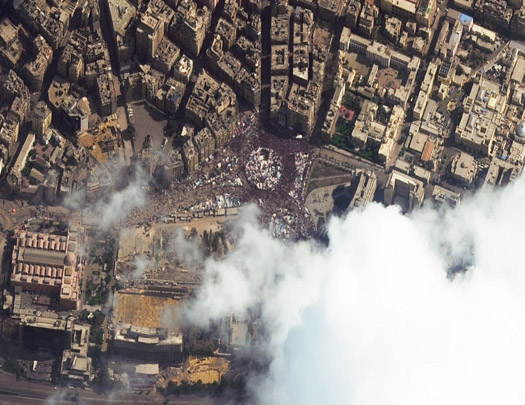
[via The Atlantic]
But why was Tahrir Square so important to the success of the protest?
A reading of the urban space of Cairo informed by both the revolution and Canetti’s Crowds and Power might go a long ways towards answering this. After opening the book with an argument that “there is nothing that man fears more than the touch of the unknown”, Canetti continues:
It is only in a crowd that man can become free of this fear of being touched… the crowd he needs is the dense crowd, in which body is pressed to body; a crowd, too, whose physical constitution is also dense or compact, so that he no longer notices who it is that presses against him… the more fiercely people press together, the more certain they feel that they do not fear each other. This reversal of the fear of being touched belongs to the nature of crowds. The feeling of relief is most striking where the density of the crowd is the greatest.
The open and closed crowd
As soon as [the crowd] exists at all, it wants to consist of more people: the urge to grow is the first and supreme attribute of the crowd. It wants to seize everyone within reach; anything shaped like a human being can join it. The natural crowd is the open crowd; there are no limits whatever to its growth; it does not recognize houses, doors or locks and those who shut themselves in are suspect. “Open is to be understood here in the fullest sense of the word; it means open everywhere and in any direction. The open crowd exists so long as it grows; it disintegrates as soon as it stops growing.For just as suddenly as it originates, the crowd disintegrates. In its spontaneous form it is a sensitive thing. The openness which enables it to grow is, at the same time, its danger. A foreboding of threatening disintegration is always alive in the crowd. It seeks, through rapid increase, to avoid this for as long as it can; it absorbs everyone, and, because it does, must ultimately fall to pieces.
In contrast to the open crowd which can grow indefinitely and which is of universal interest because it may spring up anywhere, there is the closed crowd.
The closed crowd renounces growth and puts the stress on permanence. The first thing to be noticed about it is that it has a boundary. It establishes itself by accepting its limitation. It creates a space for itself which it will fill. This space can be compared to a vessel into which liquid is being poured and whose capacity is known. The entrances to this space are limited in number, and only these entrances can be used; the boundary is respected whether it consists of stone, of solid wall, or of some special act of acceptance, or entrance fee. Once the space is completely filled, no one else is allowed in. Even if there is an overflow, the important thing is always the dense crowd in the closed room; those standing outside do not really belong.
The boundary prevents disorderly increase, but it also makes it more difficult for the crowd to disperse and so postpones its dissolution. In this way the crowd sacrifices its chance of growth, but in staying power. It is protected from outside influences which could become hostile and dangerous and it sets its hope on repetition. It is the expectation of reassembly which enables its members to accept each dispersal. The building is waiting for them; it exists for their sake and, so long as it is there, they will be able to meet in the same manner. The space is theirs, even during the ebb, and in its emptiness it reminds them of the flood.

[from open protest to closed camp - click through to BBC for interactive version]
What’s instructive about Canetti’s crowd theory is the importance it places on a crowd’s self-perception, particularly how it perceives its own density, which in turn affects its ability to either grow forcefully or remain resilient. Social media clearly can augment these perceptions, especially during the nascent stages of a protest (and, of course, provides space for lines of communication that are not available in physical space). But when a revolution like Egypt’s calls for bodies in the streets, the space of those streets deserves detailed consideration as well.
It’s easy to imagine this becoming a terrific urban design studio — streets for people extended to streets for permanent revolution, re-working the fabric of cities to better accommodate the ability of the seemingly-powerless masses to exert their mass against ruling elites — thick with both exciting spatial possibilities and thorny ethical problems.
[Thanks to Nam Henderson for some of the above links. Also check out the website for the Urban Design and Civil Protest exhibit (h/t Kush Patel), particularly Max Page's essay, for more on this topic.]
Monday, February 21. 2011
The Garden Library for Refugees and Migrant Workers
Via ArchDaily
-----
by Andrew Rosenberg

© R.Kuper
Architects: Yoav Meiri Architects
Location: Tel Aviv, Israel
Client: Arteam – Interdisciplinary Art Team
Project area: 50 sqm
Project year: 2010
Photographs: Y.Meiri, R. Kuper, T. Rogovski
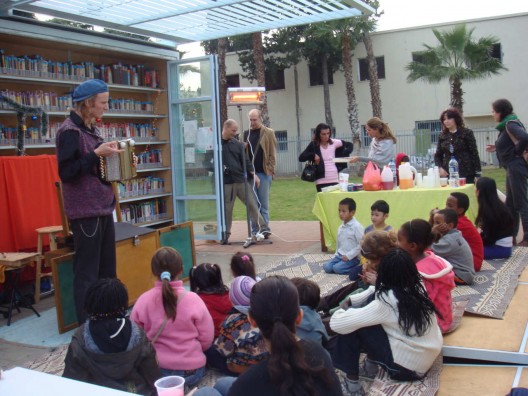
© Y.Meiri
The Garden Library for Refugees and Migrant Workers was founded in 2010 as a social-artistic urban community project. The project sees the right to a book as a fundamental human right and a possibility of both escape and shelter from daily misfortunes.
The library is located in the Levinski Park, by the Tel Aviv central bus station. The park is the place migrant workers congregate on weekends. It was important for us that the library come to the people, that those who maintain illegal immigrant status will come without fear, that the library would not have a closed door or a guard at the entrance who would check and ask questions.
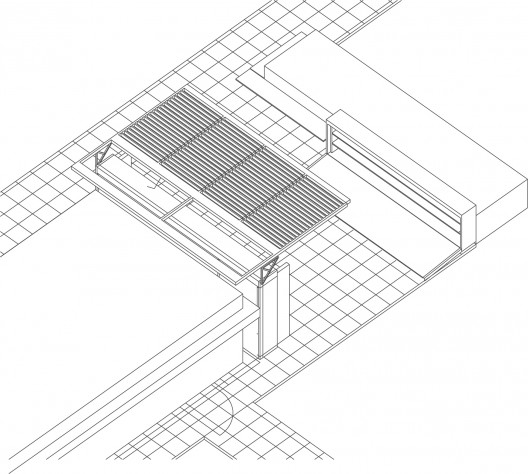
diagram 01
The library has no walls or door. It is comprised of two bookcases, which are supported by the walls of a public shelter located in the heart of the park. The taller structure contains books for the adult readers. It is transparent and illuminated from within so that, at night, the books glow in the park. Across from it is a shorter – children’s height – cabinet. The doors to the small cabinet swing down to form a parquet floor for the children to sit on and review the books.

© T.Rogovski
The door of the tall cabinet, open to form a canopy that stretches above the two structures, and provides shelter from the sun and rain, protects the books and the visitors, and establishes a space for browsing, reading and social meetings.
The library contains approximately 3,500 books in Mandarin Chinese, Amharic, Thai, Tagalog, Arabic, French, Spanish, Nepalese, Bengali, Hindi, Turkish, Romanian, and English. The children’s cabinet also holds books in Hebrew.
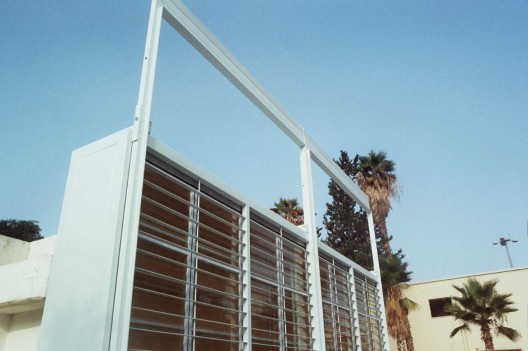
© Y.Meiri
The books are not catalogued according to conventions of genre or author name, but according to the feeling they arouse. Every detail in the sorting and categorization system reflects the spirit of the library: The library is a small and parallel world: the books wander between the shelves as their readers have wandered/are wandering the world. They carry with them their emotional history. The placement of the book is not decided by popular vote, but by the last reader. Even if ten readers thought a book was amusing and the eleventh thought it was dull, the book will move to the Boring shelf – at least until the next reader weighs in.
Related Links:
Personal comment:
Beside the fact that we can enjoy to see a constructive project regarding migration and migrant people (so to say: not some stupid propaganda and populism), I also find interesting on a more trivial or spatial aspect the mashup between two public programs: the parc and the library.
Wednesday, November 10. 2010
I-Weather as Deep Space Public Lighting - follow up & pictures
By fabric | ch
-----
One month and a half ago, we were presenting a new work during the 2010 01SJ Biennial in South Hall, San Jose -- an amazingly big air conditioned (and sort of inflated) hall in the downtown area -- (in San Jose, San Francisco Bay Area, CA), under the exhibition main title "Build Your Own World".
This artificial interior landscape cut from natural light was the ideal place to set up I-Weather as Deep Space Public Lighting, a new work from fabric | ch that uses I-Weather, the open source artificial climate based on human metabolism, circadian rythms and on medical knowledge about light therapy and chronotherapy.
The main purpose of the installation, as mentioned earlier on this blog, was to "propose a critical use of I-Weather as a model for a metabolic public lighting source, distributed and synchronized through an imaginary Deep Space Internet into the confined and conditioned environments of space exploration vehicles or into speculative public spaces of “distant colonies”".
What could a public space offer in 2010? How could public lighting --an old technology... that still defines most part of the public space at night-- evolve? What is the nature of space in Outer Space, is it public, private? If it is a public space -- by now, space exploration has been mostly supported by public fundings... --, could we light it up with a public and open source artificial climate, distributed through a new type of Internet? These were some of the ideas we tried to adress through this piece.
And here are (finally!) some follow-up pictures of the installation.
Yellow-Orange time ("night"):
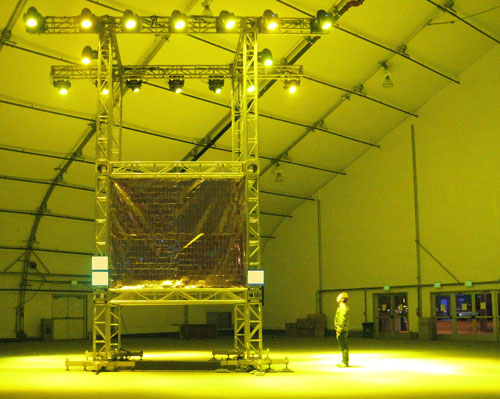
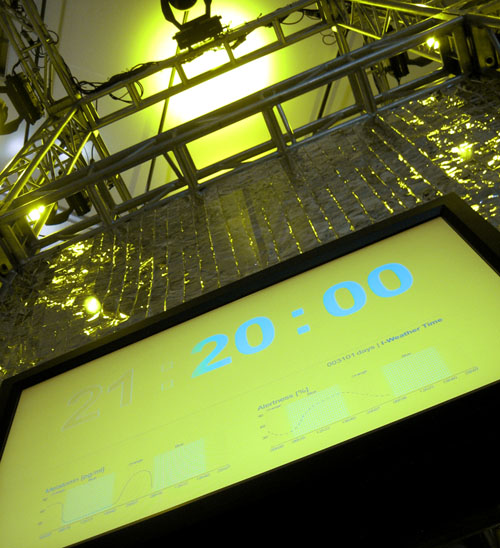
.jpg)
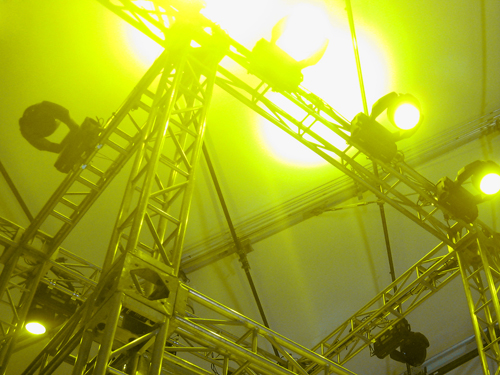
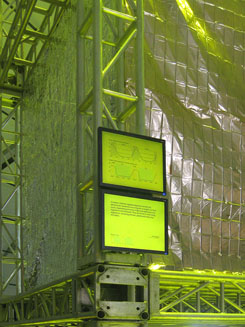

According to the lighting and color rules of I-Weather, yellow-orange light (above) doesn't affect your body clock, it is therefore similar to a night situation, but where you can still undertake calm activities. At some periods (just below), I-Weather as Deep Space Public Lighting presented the full color spectrum of I-Weather, a gradient that vary from blue to orange (day to night) and that could also therefore be read as a "time rainbow". Below, in blue, is the day time (blue light blocks the secretion of melatonin into the body).
Gradient time ("time rainbow", all times at the same time):
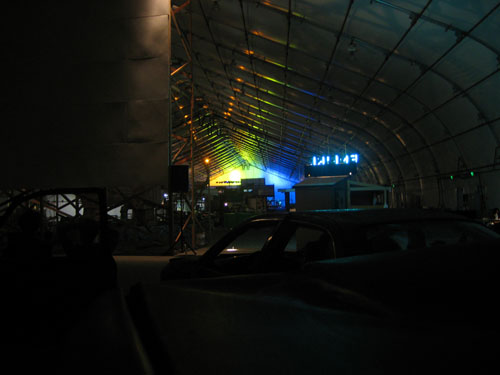
Blue time (day):


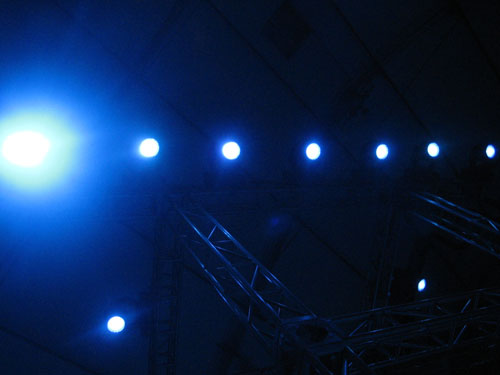
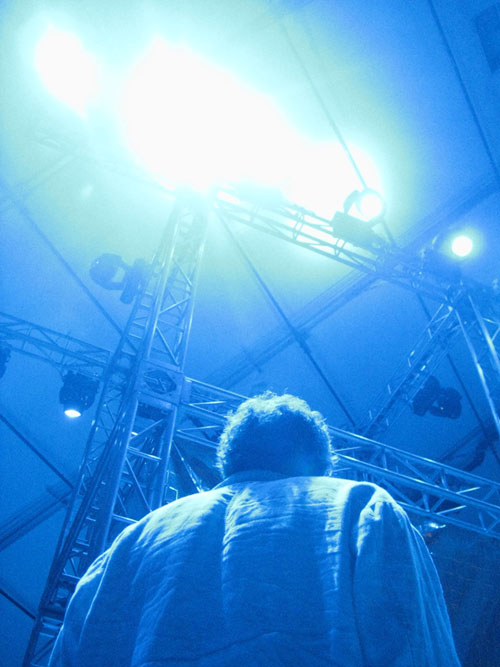
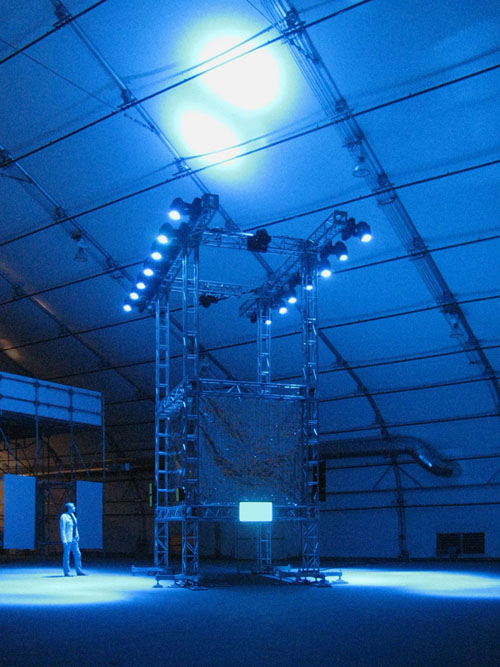
---
I-Weather has been produced with the support of Swissnex San Francisco and Pro Helvetia.
Sunday, September 05. 2010
ZERO1: The 2010 01SJ Biennial
-----
-
Practical Information:
The 2010 01SJ Biennial (ZERO1) presents artwork, performance, special events, and talks from September 16th through 19th under the theme, “Build Your Own World.”
swissnex San Francisco supports three projects included in this year’s interdisciplinary, multi-venue digital art Biennial. I-Weather as Deep Space Public Lighting, by fabric | ch, in the South Hall proposes an open source, artificial climate and public light source based on human metabolism that could be distributed through an imaginary “Deep Space Internet” to intergalactic colonies. Tomato Quintet, by Chris Chafe, Greg Niemeyer, Sasha Leitman, and Curtis Tamm, also shows in the South Hall. This piece both sonifies and visualizes the difference in air quality between a chamber housing ripening tomatoes and the ambient environment. At the San Jose Museum of Art, artist Camille Scherrer’s Le Monde des Montagnes (The World of Mountains) blends low and high tech in an interactive, ditigal fairy tale. Her augmented reality storybook lets viewers flip through the pages only to find magical animations appear on a nearby computer monitor.
With support from Pro Helvetia, the Swiss Arts Council. Stay tuned for related event announcements.
| I-Weather |
| Tomato Quintet |
| Le Monde des Montagnes |
-
Related events
Retro-Tech Gallery Talk
September 16, 2010 at 12:00 pm
With Kristen Evangelista, associate curator and curator of the exhibition and Camille Scherrer
-----
I-Weather as Deep Space Public Lighting (2010), by fabric | ch
fabric | ch is Christian Babski, Stéphane Carion, Christophe Guignard, and Patrick Keller. The Lausanne, Switzerland team formulates new architectural proposals and produces radical livable spaces. In 2001, architect Philippe Rahm and fabric | ch set up I-Weather.org, an open source, artificial climate based on human metabolism, circadian rhythms, and light therapy research. I-Weather.org envisioned synchronizing and distributing climate to any physical or digital space connected to I-Weather’s server.
In 2008, NASA announced the first successful communication with a distant spacecraft 20 million miles away via the Deep Space Internet, a model for a forthcoming interplanetary Internet. At the 01SJ Biennial, fabric | ch takes this idea to its conclusion by setting up I-Weather Deep Space Public Lighting, a metabolic public light source distributed through the imagined Deep Space Internet spaceships and intergalactic colonies.
Tomato Quintet (2007/2010), by Chris Chafe, Greg Niemeyer, Sasha Leitman, and Curtis Tamm
Tomato Quintet (2007/ 2010) is a “musification” and visualization of the air quality differences between a container of ripening tomatoes and the ambient environment. Tent walls made from sheets of Mylar are induced to vibrate through transducers attached to the top and bottom. Visitors to the tent will find a Plexiglass chamber filled with green tomatoes. During the course of the show, the green tomatoes will ripen to perfection while air quality sensors measure the gas output (CO, CO2, NO2, plus temperature and light). The Tomato Quintet 2.0 software will compare the patterns and differences of air qualities in the two spaces and render them audibly through speakers and headphones. On the final day of the Biennial, the project will convert the ripe tomatoes into salsa for guests to enjoy during lunch, accompanied by the sounds of the tomato ripening data accelerated by a factor of 240X.
Le Monde des Montagnes (The World of Mountains) by Camille Scherrer
In Le Monde des Montagnes (The World of Mountains) (2008), Swiss artist and designer Camille Scherrer blends low and high tech to push storybooks into an interactive realm. She has created a digital fairy tale, enlisting both her background in illustration and new media art. As the reader turns the pages of an ordinary book, a nearby computer monitor displays the very same pages augmented with mysterious animations of birds and snowflakes. Scherrer created this magical illusion with custom software and a reading lamp that contains a hidden camera.
Scherrer likes to play at the intersection of technology and art, looking for new fields of investigation. In Le Monde des Montagnes, she created her own universe inspired by the mountains where she grew up. She graduated in 2008 from the University of Art and Design, Lausanne (ECAL) in visual communication and works at EPFL+ECAL Lab, whose mission is to foster innovation at a crossroads between technology, design, and architecture. Her project was awarded Best European Design Diploma (Talent exhibition, Design huis, Eindhoven) and has been exhibited and published internationally.
Friday, July 16. 2010
EU Space Agency Wants to Build a Doomsday Ark on the Moon
Via TreeHugger
-----
by Michael Graham Richard, Ottawa, Canada

Apollo 17 astronaut Harrison Schmitt standing next to boulder at Taurus-Littrow during third EVA. Photo: NASA, Public domain.
Our Savior in the Sky
While Japan would like to build a solar power station on the Moon, the European Space Agency is thinking even further ahead: What if some terrible catastrophe (for more info, read about existential risks) were to wipe out a large fraction of humanity? A lot of knowledge would be lost, many species could be completely wiped out, and the survivors would have to almost literally reinvent the wheel. How would a a base on the moon help them get back on their feet? It's pretty clever. Read on for the details.

Photo: Flickr, CC
The construction of a lunar information bank, discussed at a conference in Strasbourg last month, would provide survivors on Earth with a remote-access toolkit to rebuild the human race.A basic version of the ark would contain hard discs holding information such as DNA sequences and instructions for metal smelting or planting crops. It would be buried in a vault just under the lunar surface and transmitters would send the data to heavily protected receivers on earth. if no receivers survived, the ark would continue transmitting the information until new ones could be built. (source)
So the goal would be to have a kind of Wikipedia accessible to the survivors, except that this Wikipedia would try to make it as easy to understand things and follow instructions to reacquire various technologies. It would also contain DNA information to eventually allow the revival of various species of plants and animals that might have also disappeared. It's a bit similar to the Svalbard Global Seed Vault, except in an even more robust location.
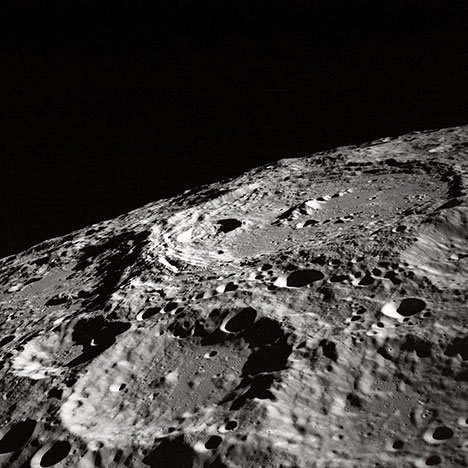
Photo: NASA, Public domain.
The databank would need to be buried under rock to protect it from the extreme temperatures, radiation and vacuum on the moon. It would be run partly on solar power. The scientists envisage placing the first experimental databank on the moon no later than 2020 and it could have a lifespan of 30 years. The full archive would be launched by 2035.(source)
The information would be in many languages (such as Arabic, Chinese, English, French, Russian and Spanish), and there would be at least 4,000 "Earth repositories" that would provide shelter, food, a water supply for survivors.
Of course, it's still much better to prevent catastrophes from happening in the first place (which is why we need a better system to monitor asteroids and comets, as well as super-volcanos, and we need to make the likelihood of thermonuclear war as small as possible), but it can't hurt to plan for the worse case scenario. Right now, all of our eggs are in the same basket. After all, existential risks might be unlikely, but they only need to happen once.
Via Daily Galaxy
More Green Space Tech
Luna Ring: A Giant Solar Power Plant on the Moon
Japan's Moonshot? $21 Billion Invested in Space-Based Solar Power
fabric | rblg
This blog is the survey website of fabric | ch - studio for architecture, interaction and research.
We curate and reblog articles, researches, writings, exhibitions and projects that we notice and find interesting during our everyday practice and readings.
Most articles concern the intertwined fields of architecture, territory, art, interaction design, thinking and science. From time to time, we also publish documentation about our own work and research, immersed among these related resources and inspirations.
This website is used by fabric | ch as archive, references and resources. It is shared with all those interested in the same topics as we are, in the hope that they will also find valuable references and content in it.
Quicksearch
Categories
Calendar
|
|
July '25 | |||||
| Mon | Tue | Wed | Thu | Fri | Sat | Sun |
| 1 | 2 | 3 | 4 | 5 | 6 | |
| 7 | 8 | 9 | 10 | 11 | 12 | 13 |
| 14 | 15 | 16 | 17 | 18 | 19 | 20 |
| 21 | 22 | 23 | 24 | 25 | 26 | 27 |
| 28 | 29 | 30 | 31 | |||

